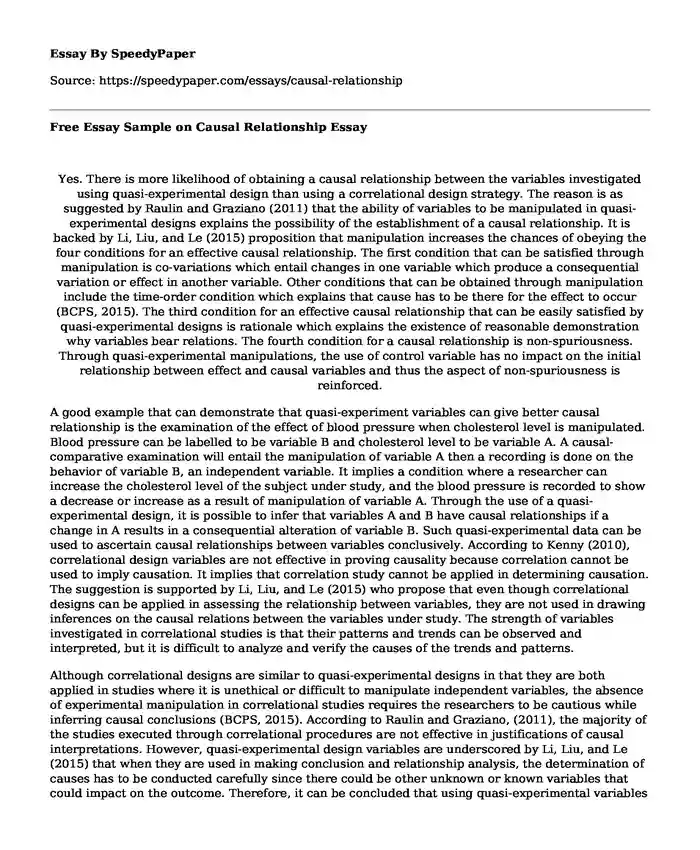
| Type of paper: | Essay |
| Categories: | Psychology Sociology Research |
| Pages: | 3 |
| Wordcount: | 655 words |
Yes. There is more likelihood of obtaining a causal relationship between the variables investigated using quasi-experimental design than using a correlational design strategy. The reason is as suggested by Raulin and Graziano (2011) that the ability of variables to be manipulated in quasi-experimental designs explains the possibility of the establishment of a causal relationship. It is backed by Li, Liu, and Le (2015) proposition that manipulation increases the chances of obeying the four conditions for an effective causal relationship. The first condition that can be satisfied through manipulation is co-variations which entail changes in one variable which produce a consequential variation or effect in another variable. Other conditions that can be obtained through manipulation include the time-order condition which explains that cause has to be there for the effect to occur (BCPS, 2015). The third condition for an effective causal relationship that can be easily satisfied by quasi-experimental designs is rationale which explains the existence of reasonable demonstration why variables bear relations. The fourth condition for a causal relationship is non-spuriousness. Through quasi-experimental manipulations, the use of control variable has no impact on the initial relationship between effect and causal variables and thus the aspect of non-spuriousness is reinforced.
A good example that can demonstrate that quasi-experiment variables can give better causal relationship is the examination of the effect of blood pressure when cholesterol level is manipulated. Blood pressure can be labelled to be variable B and cholesterol level to be variable A. A causal-comparative examination will entail the manipulation of variable A then a recording is done on the behavior of variable B, an independent variable. It implies a condition where a researcher can increase the cholesterol level of the subject under study, and the blood pressure is recorded to show a decrease or increase as a result of manipulation of variable A. Through the use of a quasi-experimental design, it is possible to infer that variables A and B have causal relationships if a change in A results in a consequential alteration of variable B. Such quasi-experimental data can be used to ascertain causal relationships between variables conclusively. According to Kenny (2010), correlational design variables are not effective in proving causality because correlation cannot be used to imply causation. It implies that correlation study cannot be applied in determining causation. The suggestion is supported by Li, Liu, and Le (2015) who propose that even though correlational designs can be applied in assessing the relationship between variables, they are not used in drawing inferences on the causal relations between the variables under study. The strength of variables investigated in correlational studies is that their patterns and trends can be observed and interpreted, but it is difficult to analyze and verify the causes of the trends and patterns.
Although correlational designs are similar to quasi-experimental designs in that they are both applied in studies where it is unethical or difficult to manipulate independent variables, the absence of experimental manipulation in correlational studies requires the researchers to be cautious while inferring causal conclusions (BCPS, 2015). According to Raulin and Graziano, (2011), the majority of the studies executed through correlational procedures are not effective in justifications of causal interpretations. However, quasi-experimental design variables are underscored by Li, Liu, and Le (2015) that when they are used in making conclusion and relationship analysis, the determination of causes has to be conducted carefully since there could be other unknown or known variables that could impact on the outcome. Therefore, it can be concluded that using quasi-experimental variables through manipulation and coupling with other controls; it can lead to a higher confidence for obtaining causal relationship.
BCPS. (2015). Types of Quantitative Design. Retrieved from BCPS: https://www.bcps.org/offices/lis/researchcourse/develop_quantitative.html
Kenny, D. (2010). Correlation and causality. New York: Wiley.
Li, J., Liu, L., & Le, T. D. (2015). Practical approaches to causal relationship exploration. Cham: Springer.
Raulin, M., & Graziano, A. (2011). Quasi-Experiments and Correlational Studies. New York: State University of New York.
Cite this page
Free Essay Sample on Causal Relationship. (2017, Sep 26). Retrieved from https://speedypaper.net/essays/causal-relationship
Request Removal
If you are the original author of this essay and no longer wish to have it published on the SpeedyPaper website, please click below to request its removal:
- Free Essay on National Identity and Feminism
- Essay Sample on Employees' Motivation in Cincinnati Financial Corporation
- The Fault in Our Stars - Book Review Essay Sample
- Free Essay on the Statement: Reality Is Merely an Illusion, Albeit a Very Persistent One
- Free Essay: The Concept of Effective Population Size
- Paper Example. The Social Determinants of Health
- Essay Sample on Do Financial Incentives Influence Employees Intrinsic Motivation?
Popular categories




